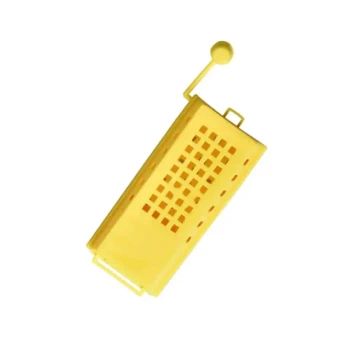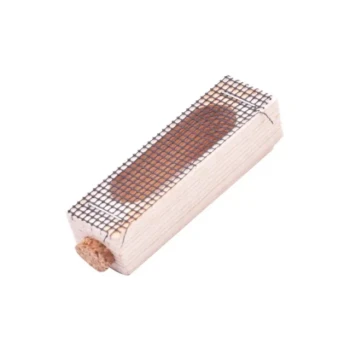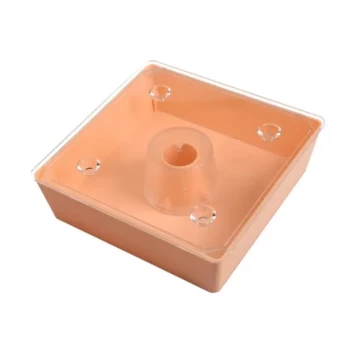In short, a properly collected semen sample should be uniform in both color and density. This visual consistency is the first and most critical indicator of a complete, high-quality collection, free from contaminants that could compromise its viability.
The primary goal of visual inspection is to confirm uniformity. Any deviation from a consistent, milky appearance signals a potential problem with the collection process or the health of the animal, requiring immediate attention.

The Hallmarks of a Quality Sample
A quick visual assessment is the first gate a semen sample must pass. Understanding what to look for—and what to avoid—is fundamental to the success of any breeding program.
Uniform Color
The ideal color for most species is a milky, opaque white or a rich cream. This appearance indicates a high concentration of sperm cells, which is the primary goal of collection.
The color should be consistent throughout the entire sample, with no streaks or spots of other hues.
Consistent Density
Beyond color, the sample should have a homogenous, even consistency. There should be no visible separation or layering within the collection vial.
A sample that appears uniform from top to bottom suggests that all fractions of the ejaculate, especially the sperm-rich portion, have been successfully captured.
Interpreting Visual Inconsistencies
Deviations from the uniform standard are not merely cosmetic; they are direct indicators of specific problems that can render a sample useless.
Discoloration as a Red Flag
Any color other than white or cream is a warning sign. Yellowish tints often indicate the presence of urine, which is spermicidal and will destroy the sample.
Pink, red, or brownish hues signal the presence of blood. This could be due to an injury sustained during collection or an underlying health issue like an infection, both of which require investigation.
Issues with Density and Texture
If the sample appears watery, thin, or translucent, it may be an incomplete collection that missed the sperm-rich fraction. It could also suggest a low sperm count in the animal.
The presence of clumps, grit, or stringy material can indicate infection, inflammation, or other pathological issues. Any foreign debris points to contamination during the collection process.
Making a Confident Assessment
Your visual inspection is a rapid diagnostic tool. Use it to make a quick, informed decision on the viability of the sample before proceeding to microscopic evaluation or processing.
- If the sample is uniformly creamy or milky white: You can be confident that you have a high-quality, complete collection ready for the next step.
- If you observe any discoloration (yellow, pink, red): The sample is compromised and should be discarded; the cause must be investigated.
- If the sample appears layered, watery, or contains debris: It likely represents an incomplete or contaminated collection and should not be used.
Trusting this initial visual check is the foundational step in maximizing reproductive success.
Summary Table:
| Characteristic | Ideal Appearance | Red Flags |
|---|---|---|
| Color | Milky white or rich cream, uniform throughout | Yellow (urine), Pink/Red (blood), any discoloration |
| Density | Homogenous, even consistency; no separation | Watery, thin, layered appearance |
| Texture | Smooth and uniform | Clumps, grit, stringy material, debris |
Ensure every collection is a success with reliable equipment from HONESTBEE.
We understand that the quality of your semen collection directly impacts your breeding program's success. HONESTBEE supplies commercial apiaries and beekeeping equipment distributors with high-quality, durable beekeeping supplies and equipment through our wholesale-focused operations. From collection tools to storage solutions, our products are designed to support the precision and hygiene required for optimal results.
Let us help you maximize your reproductive outcomes. Contact our experts today to discuss your specific needs and discover how our wholesale supplies can benefit your operation.
Visual Guide

Related Products
- Wooden Queen Bee Excluder for Beekeeping
- Professional Plastic Queen Excluder for Modern Beekeeping
- High Performance Plastic Queen Excluder for Beekeeping and Apiary Management
- Extra Wide Stainless Steel Honey Uncapping Fork with Scraper Beekeeping Tool
- Wood and Mesh Push-In Queen Cage
People Also Ask
- What are the advantages of using a queen excluder? Boost Honey Harvest Efficiency & Hive Control
- What makes polyurethane foam environmentally friendly? The Surprising Benefits of a Durable, Inert Material
- How does a queen excluder help in finding the queen bee? A Strategic Guide for Commercial Beekeepers
- Which is better, plastic or metal queen excluder? A Guide to Long-Term Hive Success
- What are the advantages of using excluders in terms of wax recovery? Maximize Your Yield of Premium Beeswax



















